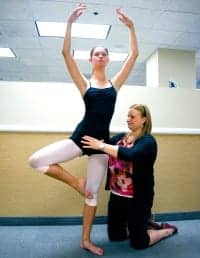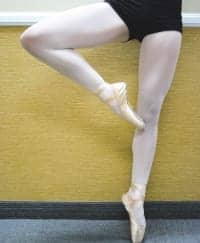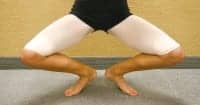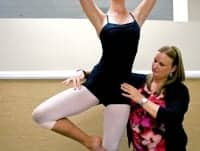
Dynamic lumbar spine and trunk stabilization provides enhanced control and coordination. Correcting alignment helps avoid muscular imbalances, thus decreasing risk for injury.

Because of the anatomy of the hip joint, more external rotation can be achieved when the hip is flexed, causing the pelvis to anteriorly rotate.

Turnout is the summation of the external rotation of all the lower limb joints with the greatest contribution from the hip.

Therapist correction for anterior pelvic tilt during hip turnout.
Although dancers are not conventionally thought of as athletes, they are highly motivated, finely physically tuned individuals and, much like athletes, place intense physical demands on their bodies in terms of endurance, aerobic capacity, muscle strength, overall flexibility, joint stability, and neuromuscular coordination.1 In these terms, the physical demands placed on the bodies of dancers may make them just as susceptible as football players to injury. And unless injuries are significant, dancers often do not pay attention to them. The same incentives exist for an athlete or dancer to perform through pain and injury, as both have alternate participants willing to take their place. Therefore, it is important for the clinician to identify a dancer as an athlete and be able to recognize movement patterns correlated with common dance injuries.
Research reports the incidence of injuries in dancers ranges from 17% to 95%, with most prevalent injuries occurring in the foot/ankle (53%), followed by the hip (21.6%), knee (16.1%), and back (9.4%).2,3 Injuries can be either acute or chronic, and about 60% to 76% of dance-related injuries are microtraumatic in nature, characterized as “overuse injuries.”4 The dancer’s technique is the key to artistic movements, incorporating proper and aesthetically pleasing alignment and biomechanics. Chronic improper biomechanics and faulty alignment increase the dancer’s risk for injury. Deviations from proper alignment may result in small irritations to the misaligned structures, but these irritations usually go unnoticed (or ignored) by the dancer, and can accumulate over time. Eventually, the dancer develops muscle imbalances, painful motions, and compensatory movement patterns, further encouraging improper biomechanics and structural irritation.
Most injuries affecting dancers are caused by long-term biomechanical problems relating to “turnout.” Turnout is a term that refers to the desired maximal external rotation of the lower extremity, with encouraged external rotation to 180 degrees. Turnout is the summation of the external rotation of all the lower limb joints, with the hip providing the greatest contribution (60%) and the rest coming from the knee, ankle, and foot.1 Because of the anatomy of the hip joint and its ligaments, more external rotation can be achieved when the hip is flexed, causing the dancer to anteriorly rotate the pelvis (tip the pelvis forward) and plant their feet firmly on the floor. Over time, this results in shortened hip flexor musculature and knee hyperextension. As a result, the lumbar spine becomes hyperlordotic and the feet adopt a valgus position at the heel with related forefoot pronation. These compensations facilitate a cascade of improper biomechanics related to malalignment.1,5 In an article by Shah, it was found that dancers demonstrate up to 30% more hip external rotation range of motion, 8% more hip flexion range of motion, and 15% more hip abduction range of motion as compared to the nondancer population.6 Many dancers also have excess motion in inversion/eversion of the subtalar joint and dorsiflexion of the first MTP with decreased plantar flexion at the first MTP, indicating a biomechanical imbalance putting a dancer’s foot at risk for injury, especially in the foot/ankle.6
The table below includes, but is not exclusive to, common dance injuries.1
Some of the other contributing factors leading to dance injuries include age; measured average range of motion; prior injury; fatigue; overall health and nutrition; type of dance and frequency of classes, rehearsals, and performances; duration of training; environmental conditions such as hard floors and cold studios; equipment used, especially shoes; and the individual dancer’s body alignment.4,7
Goals of a rehab program for the dancer should include pain reduction, restoration of full range of motion to all joints through the kinetic chain, and restoration of balanced strength and flexibility of individual muscles and muscle groups. These goals can be reached using a combination of modalities, exercises, and manual therapy techniques, including soft tissue mobilization and joint mobilization, to individually address deficits and specific movement patterns. The final goal, and most crucial to full rehabilitation of the dancer, is dynamic lumbar spine and trunk stabilization, providing enhanced control and coordination of the spine and lower extremities, and improving balance, proprioception, and muscular control. Correcting alignment abnormalities and compensatory misalignments helps the dancer avoid muscular imbalances, thus decreasing the risk for injury.5
Proper stretching should be encouraged, but not overstretching. All dancers want to stretch in an externally rotated position to help improve their turnout, therefore it is critical to teach the necessity of stretching in parallel to restore muscle balance. Static strengthening of the lower extremities is not generally necessary. The lateral structures (hip abductors and IT band) and hip flexors are commonly tight and adaptively shortened; therefore, further strengthening should be avoided. Using a foam roller to allow greater soft tissue extensibility to the lateral structures, especially the IT band, proves as useful. The dancer also may use the foam roller to stretch other structures, including the hip flexors and gastroc-soleus complex. Hip adductor strength is crucial for holding turnout and should be strengthened in both open- and closed-chain positions. The hamstrings also may require strengthening as a result of stretch-lengthening due to alignment faults. A therapeutic ball, used in lying, sitting, prone, and supine positions, may be useful in strengthening and relearning proper movement patterns.
The abdominals require the most attention, as they support the back and pelvis, allowing the dancer to better tolerate lower extremity dynamic strengthening. Dynamic stabilization training of the lumbar spine is the key to providing control of the trunk during lower extremity movement. This training should include not only movements of the spine and torso over the pelvis, but also movement of the pelvis on the torso and spine. Similarly, trunk training also should include both the lower extremities moving on the pelvis and the pelvis moving on the fixed extremities. Sports cords, therapeutic balls, or spring resistance apparatus, including the Pilates Method, may be useful to the dancer for these types of strengthening. Functional rotation can be addressed by having the dancer stand on rotating disks to isolate hip internal and external rotation while maintaining stabilization of the abdomen and lumbar spine. Plyometric exercises should be included for dancers who require jumping, especially focusing on eccentric closed-chain activity. It can begin on a simple trampoline and progress to more complex systems, such as a spring resistance apparatus. Balance and proprioception also should be addressed for dynamic control and neuromuscular reeducation. This can be achieved using air-filled discs or an uneven surface, or simply by standing on one foot and reaching away from the body’s base of support and center of gravity.5
Clinicians not only should be able to help a dancer return to their sport, but help educate them to prevent future injuries. Dance medicine shares many principles with sports medicine, yet continues to develop on its own. To some people, dance may not be a sport, but dancers are surely the aesthetic athlete.
Kimberly R. Witkowski, PT, DPT, OCS, is a staff physical therapist at Mariners Physical Therapy, South Coast Metro, Calif. She received her DPT from Loma Linda University, graduating with honors and receiving the Fred B. Moore Award for excellence in clinical practice. She has worked with many types of orthopedic diagnosis at many different levels and utilizes manual therapy, functional rehabilitation, and movement science techniques in her practice. For more information, contact .
COMMON DANCE INJURIES
1. Foot/Ankle
- ATFL sprain
- Posterior tibialis tendonitis
- Anterior ankle impingement syndrome
- Posterior ankle impingement syndrome
- Os trigonum impingement syndrome
- FHL tendonitis
- Achilles tendon pathology
- Dancer’s fracture (MT5 neck stress fracture)
- Tarsal subluxations
- MT stress fracture (especially MT2)
- Hallux rigidus
- Hallux valgus
- Sesamoid lesions
- Interdigital neuromas
- Plantar fasciitis
2. Hip
- Snapping hip
- Labral tears
- Osteoarthritis
- Stress fracture of femoral neck
- Avulsion injuries (at apophyses on growing bone)
- Femoral neurapraxia
- SIJ dysfunction
- Trochanteric bursitis
- Piriformis syndrome
3. Knee
- IT band syndrome
- Patellofemoral syndrome
- ACL rupture
- MCL sprain
- Patellar chondromalacia
References
- Motta-Valencia K. Dance-related injury. Phys Med Rehabil Clin N Am. 2006;17(3):697-723. Available at: www.med.nyu.edu/pmr/residency/resources/PMR%20clinics%20NA/PMR%20clinics%20NA_sports%20med/dance%20related%20injury.pdf. Accessed April 18, 2012.
- Gamboa JM, Roberts LA, Maring J, Fergus A. Injury patterns in elite preprofessional ballet dancers and the utility of screening programs to identify risk characteristics. J Orthop Sports Phys Ther. 2008;38(3):126-136. Available at: www.ncbi.nlm.nih.gov/pubmed/18383646. Accessed April 18, 2012.
- Bronner S, Ojofeitimi S, Rose D. Injuries in a modern dance company: effect of comprehensive management on injury incidence and time loss. Am J Sports Med. 2003;31(3):365-373. Available at: www2.brooklyn.liu.edu/bbut04/adamcenter/files/Bronner-AA.pdf. Accessed April 18, 2012.
- Morgan V. Common Lower Extremity Injuries Affecting Female Dancers and a Proposed Screening Tool for Identifying Dancers Prone to Injury. Available at: www.lulu.com/items/volume_67/8564000/8564329/1/print/Dance_Injuries.pdf. Accessed April 18, 2012.
- Weiss D, Zlatkowski M. Rehabilitation of dance injuries to the shoulder, lumbar spine, pelvis and hip. Orthop Phys Ther Clin North Am. 1996;5(4):477-495. Available at: www.performingartspt.com/downloads/ortho_clinics_dance_pt_3.pdf. Accessed April 18, 2012.
- Shah S. Caring for the dancer: special considerations for the performer and troupe. Curr Sports Med Rep. 2008;7(3):128-132. Available at: www.ncbi.nlm.nih.gov/pubmed/18477868. Accessed April 18, 2012.
- Stop Sports Injuries: Dance Injuries. Available at: www.stopsportsinjuries.org/dance-injury-prevention.aspx. Accessed April 18, 2012.




